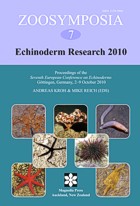Abstract
The stellate echinoderms (crinoids, ophiuroids, asteroids) have arms that are involved in feeding. Arms are extensions from the central body and affect the form of the organism. The arms of crinoids, ophiuroids and asteroids differ in structure and have different characteristics. Crinoids are pentaradiate and primitively pentabrachiate, with an internal skeletal support that permits up and down movements. Although branching of the arms occurs, the basic structure remains unchanged. This, along with the mouth on the upper surface, i.e. directed away from the substrate, means that the food of crinoids has always been microplankton. The mouth of ophiuroids is directed towards the substrate. The internal skeletal support of their arms permits both up and down and lateral movements. Like crinoids, most ophiuroids are pentaradiate and pentabrachiate, with supernumerary arms being limited in number. Branching of ophiuroid arms occurs only in some euryalids. Ophiuroid arms also have spines, which do not occur in the arms of crinoids. With these characteristics, food of ophiuroids includes not only microplankton but also nekton, benthic particles and small prey. The major distinction of asteroids from crinoids and ophiuroids is that skeletal support of asteroid arms is external. Like ophiuroids, the mouth is directed toward the substrate. Unlike crinoids and ophiuroids, digestion in asteroids involves direct contact between the stomach and the prey and is extraoral in most asteroid taxa. Expansion of the oral surface increases the area over which the stomach can be extended and increases the capacity for feeding. This has occurred in two ways in stellate echinoderms: extension of the interradii in five-armed species and connection of the proximal parts of the rays in multiarmed species. Asteroid arms are not branched. Modified spines (pedicellariae) are used for feeding. The array of food is more extensive in asteroids because of these features including surface prey, particles, multiple small prey, macroprey and nekton. The form of the arm of each stellate group has constraints and potentials that determine food and feeding.

